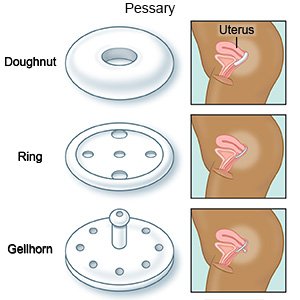Pessary
Medically reviewed by Drugs.com. Last updated on Apr 6, 2025.
AMBULATORY CARE:
What you need to know about a pessary:
A pessary is a small silicone device that fits in your vagina. A pessary helps support your bladder, uterus, vagina, or rectum. A pessary is used for urinary incontinence, or sagging of your organs into your vagina.
What will happen during pessary insertion:
- There are many different kinds of pessaries. Your healthcare provider will work with you to find one that fits properly and is comfortable.
- Your healthcare provider will insert the pessary. He or she will teach you how to insert the pessary correctly. He or she will also teach you how to remove the pessary for cleaning.
 |
What will happen after pessary insertion:
You may need to return in 1 to 2 days to have the pessary checked. You may have more vaginal discharge than is normal for you.
Risks of a pessary:
Your discharge may develop an odor. You may have bleeding from your vagina. Your vagina may become irritated from the pessary. You may develop sores in your vagina.
Call your doctor if:
- You are bleeding from your vagina.
- You have trouble urinating or having a bowel movement.
- You have discomfort or pain with the pessary in place.
- You have burning, itching, or irritation in your vagina from the pessary.
- Your pessary keeps falling out. This may be a sign that it is too small.
- You have questions or concerns about your condition or care.
Care for yourself at home:
- Clean your pessary with soap and water. You can do this every few days, or as directed by your healthcare provider.
- You may be able to wear the pessary during sexual intercourse. Ask your healthcare provider if sexual intercourse is okay with your pessary in place.
- If your vaginal discharge has an odor, use vaginal gel or clean your pessary more often.
- The pessary can fall out if you strain too hard or lift heavy objects. However, the pessary cannot move anywhere else inside your body.
- Do pelvic muscle exercises. These are also called Kegel exercises. These exercises help strengthen your pelvic muscles and help prevent urine leakage. Tighten the muscles of your pelvis and hold them tight for 5 seconds. Then relax for 5 seconds. Gradually work up to tightening them for 10 seconds and relaxing for 10 seconds. Do this 3 times each day.
Follow up with your doctor as directed:
You may need to return in 1 to 2 days to check the placement of the pessary. The size or shape may need to be changed to be comfortable. After that you may need to return every few weeks or months for a checkup. Write down your questions so you remember to ask them during your visits.
© Copyright Merative 2025 Information is for End User's use only and may not be sold, redistributed or otherwise used for commercial purposes.
The above information is an educational aid only. It is not intended as medical advice for individual conditions or treatments. Talk to your doctor, nurse or pharmacist before following any medical regimen to see if it is safe and effective for you.
Further information
Always consult your healthcare provider to ensure the information displayed on this page applies to your personal circumstances.
